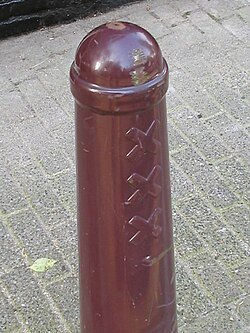Amsterdammertje
A Amsterdammertje is a typical red - brown street bollards, the sidewalks are separated from the busy street with in Amsterdam. Amsterdammertje means of the Dutch language translates to " Little Amsterdam ". The bollards are decorated with the three St. Andrew's crosses of the Amsterdam coat of arms.
History
The earliest road bollard Amsterdam were set up in 1800 by private individuals. More and more homeowners are featured at this time bollards in front of their homes to protect the side strips in front of the road. These bollards were built of iron, especially from old cannons, stone or wood. In the late 19th century, the first cast iron bollards were made and from 1915 there was a standard bollard with a weight of 70 kg of cast iron with the three St. Andrew's crosses of the Amsterdam coat of arms. This bollard already corresponded largely to today's Amsterdammertje, but was thinner and heavier.
Since 1972, the Amsterdammertje is no longer manufactured from heavy and expensive cast iron, but of steel plates with a height of 1.35 meters and a weight of only 20 kilograms. This type is used to this day in Amsterdam, all older bollards have been removed or replaced. In 1984 there were about 100,000 Amsterdammertjes.
Current use
Because trucks are driven regularly on the bollard and drive through car therethrough, put the bollards are no effective method to protect the side panel is more, and especially parking on the edge can not be effectively prevented by them. Since the 2000s the side strips were applied slightly increased, whereby the Amsterdammertjes were no longer needed to separate the road from the side stripes. Since then, about 2,000 Amsterdammertjes be removed annually. In 2003, only 37 616 Amsterdammertjes were left.
New and used Amsterdammertjes are now sold online by the Municipality of Amsterdam.









